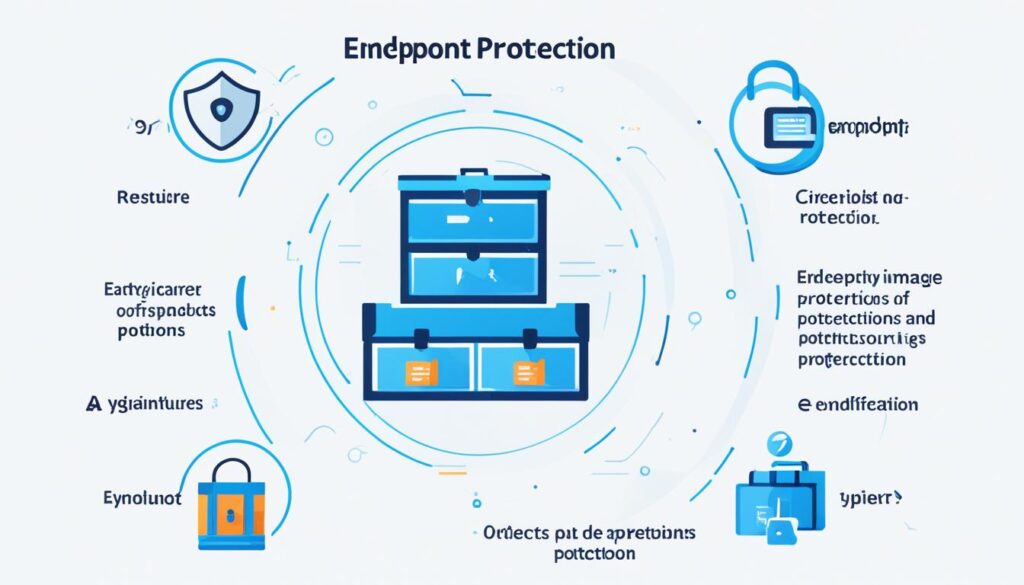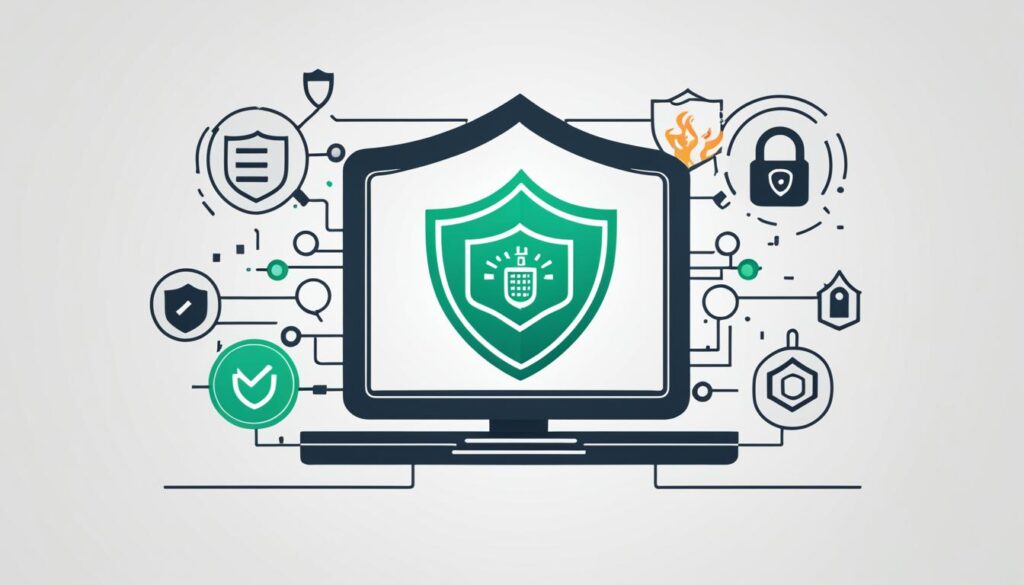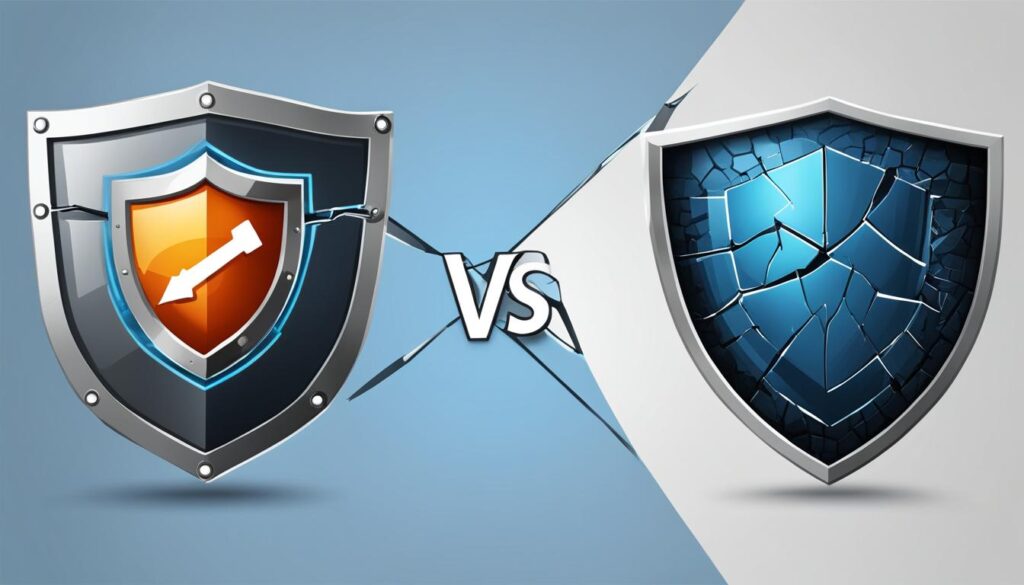Endpoint protection, also known as endpoint security, is a crucial practice in the field of cybersecurity. It involves securing the entry points or endpoints of end-user devices, such as desktops, laptops, and mobile devices, from being exploited by malicious actors and campaigns.
Endpoint security systems play a vital role in protecting these endpoints on a network or in the cloud from various cybersecurity threats. It has evolved beyond traditional antivirus software to offer comprehensive protection from sophisticated malware and evolving zero-day threats.
Key Takeaways:
- Endpoint protection is the practice of securing end-user devices from cybersecurity threats.
- It safeguards the entry points or endpoints of desktops, laptops, and mobile devices.
- Endpoint security systems protect against various malicious actors and campaigns.
- It provides comprehensive protection from advanced malware and evolving zero-day threats.
- Endpoint protection has evolved beyond traditional antivirus software.
Why Endpoint Security is Important
Endpoint protection is crucial for organizations of all sizes, as data is the most valuable asset in today’s business world. Losing access to or the integrity of that data can put the entire business at risk.
With the increase in endpoints and the rise of remote work and bring your own device (BYOD) policies, perimeter security is no longer sufficient to protect enterprise networks. The threat landscape is constantly evolving, and hackers are continuously finding new ways to gain access and steal information.
Endpoint protection platforms are regarded as must-haves in securing modern enterprises. These platforms provide comprehensive solutions to safeguard endpoints and defend against a wide range of cyber threats.
By implementing robust endpoint protection measures, organizations can:
- Prevent unauthorized access and data breaches
- Detect and block malware, ransomware, and other malicious activities
- Safeguard sensitive information and maintain data integrity
- Ensure compliance with industry regulations
- Protect against insider threats
Endpoint security solutions offer organizations the ability to secure their endpoints, regardless of location, by implementing advanced technologies such as:
- Behavioral analysis: Identifying suspicious patterns and activities to detect potential threats
- Machine learning: Analyzing vast amounts of data to identify and block new and emerging threats
- Application control: Restricting unauthorized applications from executing on endpoints
- Data encryption: Protecting sensitive data from unauthorized access
- Web security: Blocking malicious websites and preventing phishing attacks
By leveraging these endpoint security solutions, organizations can ensure the confidentiality, integrity, and availability of their critical data and systems, even in the face of evolving cyber threats.
“Endpoint protection is no longer a luxury; it is a necessity for any organization that values its data and wants to maintain a competitive edge in today’s digital landscape.”
How Endpoint Protection Works
Endpoint security plays a crucial role in keeping businesses and their valuable data safe from cyber threats. But how does endpoint protection work? Let’s dive into the features and functionalities that make it an essential component of modern cybersecurity.
Endpoint protection platforms (EPP) act as the first line of defense against malware and other malicious activities that can compromise individual devices connected to a network. These platforms leverage cloud-based threat databases to rapidly detect and block potential threats as files enter the network.
One of the key features of EPPs is their ability to provide system administrators with a centralized console for managing security remotely. This console allows administrators to push updates to endpoints, authenticate login attempts, and enforce corporate policies to ensure consistent protection across devices.
EPPs employ a variety of technologies to prevent data loss and protect endpoints against threats. Application control is one such technology that allows administrators to define which applications are allowed to run on endpoints, minimizing the risk of malware execution.
Encryption is another critical feature of endpoint protection. It ensures that sensitive data stored on endpoints is unreadable to unauthorized individuals, even if the device is compromised.
It’s worth noting that endpoint protection is not limited to traditional computers. Mobile devices, printers, servers, and even medical devices are all considered endpoints and are equally susceptible to cyber threats. Endpoint protection solutions have evolved to encompass a variety of devices, ensuring comprehensive coverage.
To summarize, endpoint protection works by safeguarding the data and workflows associated with devices connected to a network. Its key features include cloud-based threat detection, centralized administration, application control, and encryption. These features collectively provide organizations with the tools they need to proactively secure their endpoints and defend against evolving cyber threats.
What’s considered an endpoint?
Any device that connects to a network is considered an endpoint. This includes devices such as tablets, mobile devices, smart watches, printers, servers, ATM machines, and even medical devices. Endpoints, especially mobile and remote devices, are popular targets for cyber threats due to their vulnerability. As the types of endpoints continue to evolve and expand, endpoint security solutions have also adapted to protect them from exploitation.
Types of Endpoint Devices:
- Tablets
- Mobile devices
- Smart watches
- Printers
- Servers
- ATM machines
- Medical devices
Endpoints are diverse and can vary greatly depending on the industry and the specific needs of an organization. Each type of endpoint presents unique challenges and requirements for effective security measures. By understanding the different types of endpoints and their vulnerabilities, organizations can implement tailored endpoint protection strategies that address specific risks.
“The rise of IoT devices has significantly increased the number of potential endpoints, requiring organizations to adopt advanced security solutions to protect against attacks.”

Endpoints, such as mobile devices and IoT devices, pose significant security risks due to their portability and connectivity to networks. It is crucial for organizations to prioritize endpoint protection and implement robust security measures to safeguard their valuable data and prevent cyber attacks.
Endpoint Security Components
Endpoint security software encompasses several essential components that work together to provide comprehensive protection against a wide range of threats. By utilizing these components, organizations can strengthen their defenses and safeguard their valuable data and assets.
Machine Learning Classification
One of the core components of endpoint security is machine learning classification. This technology plays a crucial role in detecting zero-day threats, which are previously unknown attacks that exploit vulnerabilities before they can be patched. By continuously analyzing and learning from vast amounts of data, machine learning algorithms can identify and block emerging threats, providing proactive security measures.
Antimalware and Antivirus Protection
Advanced antimalware and antivirus protection form another vital component of endpoint security. These solutions employ sophisticated scanning techniques to identify and eliminate malware and viruses that may attempt to infiltrate the network through endpoints. By regularly updating their threat databases and employing real-time scanning, these tools ensure ongoing protection against known threats.
Proactive Web Security
Endpoint protection solutions also incorporate proactive web security features to defend against web-based threats. These components monitor user web activity, detecting and blocking malicious websites, phishing attempts, and other online threats. By providing safe browsing environments, they mitigate the risks associated with internet-based attacks.
Data Classification and Loss Prevention
Data classification and loss prevention mechanisms are crucial for protecting sensitive information and preventing data breaches. These components identify and classify data based on its level of sensitivity, applying appropriate security measures accordingly. In the event of data leakage or unauthorized access attempts, they implement preventive actions, such as encryption, access restrictions, and data backup protocols.
Integrated Firewalls
Endpoint security software often includes integrated firewalls that establish a barrier between the network and potential external threats. These firewalls monitor and control network traffic, preventing unauthorized access and blocking malicious activities. By filtering incoming and outgoing data packets, they create an additional layer of protection for the endpoint environment.
Email Gateways for Blocking Phishing Attempts
Email remains a common vector for cyberattacks, including phishing attempts. Endpoint security solutions combat this threat with email gateways that filter incoming emails, identifying and blocking phishing attempts and malicious attachments. By preventing users from interacting with malicious content, these gateways help to mitigate the risk of social engineering attacks.
Threat Forensics
Endpoint security platforms often incorporate threat forensics capabilities, allowing organizations to conduct detailed investigations and analysis in the aftermath of a security incident. These components provide vital insights into the nature of the attack, enabling organizations to enhance their security posture, fine-tune their defenses, and implement measures to prevent similar incidents in the future.
Insider Threat Protection
Insider threats pose a significant risk to organizations, as they involve malicious acts or negligence from individuals within the organization. To combat this risk, endpoint security solutions offer insider threat protection components that enforce user behavior monitoring, restrict access to sensitive data, and detect anomalous activities. These proactive measures help organizations identify and address potential insider threats before they can cause harm.
Centralized Endpoint Management
Centralized endpoint management is a fundamental component that streamlines the administration and maintenance of endpoint security across the organization. This feature allows system administrators to centrally monitor, update, and configure security settings for all endpoints. By providing a unified management console, organizations can ensure consistent security across their entire network, reducing vulnerabilities resulting from misconfigurations or outdated security policies.
Endpoint, Email, and Disk Encryption
Endpoint security software frequently includes encryption components that protect sensitive data from unauthorized access. These components can encrypt files, emails, and disk drives, ensuring that even if an endpoint is compromised, the data remains protected. By implementing encryption measures, organizations can maintain the confidentiality and integrity of their data, even in situations where physical devices are lost or stolen.

Endpoint Protection Platforms vs. Traditional Antivirus
When it comes to safeguarding your organization’s digital assets and mitigating cyber threats, choosing the right security solution is crucial. Endpoint protection platforms (EPP) and traditional antivirus solutions are two popular options with distinct approaches to security.
Traditional antivirus software focuses on protecting individual endpoints by scanning files for known malware signatures and relying on manual updates for the latest threat definitions. While these solutions have been effective in the past, they often struggle to keep up with the rapidly evolving threat landscape.
“Traditional antivirus programs will become irrelevant very soon with the rise of advanced persistent threats.”
Endpoint protection platforms, on the other hand, provide a more comprehensive and proactive approach to security. EPPs utilize cloud-based threat intelligence and advanced technologies such as behavioral analysis and machine learning to detect and protect against both known and unknown threats.
EPPs offer a centralized management console that provides visibility into the entire enterprise network. This allows system administrators to monitor and manage security remotely, enforce corporate policies, and push updates to endpoints seamlessly. The interconnected nature of EPPs ensures that any detected threat or suspicious activity is immediately shared across all endpoints, enhancing overall security.
Moreover, EPPs go beyond traditional antivirus capabilities by providing advanced features like:
- Real-time threat detection and prevention
- Behavioral analysis and machine learning
- Web security and URL filtering
- Application control and whitelisting
- Data loss prevention
- Endpoint encryption
By combining these features, EPPs offer a more robust defense against sophisticated attacks, zero-day exploits, and emerging threats that traditional antivirus solutions may struggle to detect.
Endpoint Protection Platforms vs. Traditional Antivirus
| Endpoint Protection Platforms (EPP) | Traditional Antivirus |
|---|---|
| Cloud-based threat intelligence | Signature-based threat detection |
| Behavioral analysis and machine learning | Manual updates for threat definitions |
| Centralized management console | Individual endpoint protection |
| Real-time threat detection and prevention | Scans files for known malware signatures |
| Web security and URL filtering | Limited web security capabilities |
| Application control and whitelisting | Basic application scanning |
| Data loss prevention | No data loss prevention features |
| Endpoint encryption | No encryption capabilities |

When it comes to securing your organization’s endpoints, making the right choice between an EPP and traditional antivirus is essential. While traditional antivirus still plays a role in endpoint security, EPPs offer a more comprehensive and advanced solution to protect against today’s evolving cyber threats.
How Enterprise Endpoint Protection Differs from Consumer Endpoint Protection
When it comes to endpoint protection, organizations and individual consumers have different needs and requirements. Enterprise endpoint protection focuses on managing and securing a large number of endpoints across an organization, often with different types of devices. On the other hand, consumer endpoint protection is designed to manage a smaller number of single-user endpoints.
Enterprise endpoint protection requires advanced security solutions and centralized management to effectively protect against sophisticated threats. It often involves features such as remote administration capabilities and integration with other enterprise security systems. These solutions provide comprehensive protection for organizations that handle sensitive data and must comply with industry regulations.
Consumer endpoint protection, on the other hand, is geared towards individual users and their personal devices. It typically offers basic protection against common threats such as viruses and malware. Consumer endpoint protection solutions are typically easy to install and use, catering to the needs of everyday users who prioritize simplicity and convenience.
While both enterprise and consumer endpoint protection aim to secure endpoints, they serve different purposes based on the scale and needs of the organization or individual. Enterprise solutions provide robust security features and scalability for organizations, while consumer solutions prioritize ease of use for individual users.
Key Differences Between Enterprise and Consumer Endpoint Protection:
- Scale: Enterprise solutions manage and secure a large number of endpoints, while consumer solutions focus on individual devices.
- Security Features: Enterprise solutions offer advanced features such as remote administration, centralized management, and integration with other enterprise security systems. Consumer solutions provide basic protection against common threats.
- Compliance: Enterprise solutions help organizations comply with industry regulations and secure sensitive data. Consumer solutions cater to individual users’ personal needs and preferences.
- Complexity: Enterprise solutions can be more complex due to the need for centralized management and integration with other systems. Consumer solutions prioritize simplicity and ease of use.
Understanding the differences between enterprise and consumer endpoint protection is crucial for organizations and individuals to choose the right solution that aligns with their specific needs and security requirements.

By implementing the appropriate endpoint protection solution, organizations can enhance their defenses against modern cyber threats and ensure the security and integrity of their data and systems.
The challenges of managing and securing endpoints
Managing and securing endpoints can be a daunting task for organizations, as it encompasses several challenges. These challenges arise from the sheer number and diversity of endpoints, the difficulties in discovering and onboarding endpoints, the risks associated with IoT devices and industrial control systems, the complexities of virtual desktop environments, the constantly evolving cyber threats and attack techniques, the rise of “living off the land” attacks, advanced phishing techniques, the risks posed by spyware, the management of privileged access, and the need for a defense-in-depth approach.
One of the primary challenges is the sheer number and diversity of endpoints that organizations need to manage and secure. With the proliferation of devices such as desktops, laptops, mobile phones, tablets, printers, and IoT devices, organizations must ensure that each endpoint is adequately protected against potential threats.
Discovery and onboarding of endpoints also present challenges. Organizations need to identify and authenticate each new endpoint that joins the network, ensuring that it complies with security policies and has the necessary protection measures in place. This process can be time-consuming and complex, especially in large-scale environments.
The risks associated with IoT devices and industrial control systems add another layer of complexity to endpoint security. These devices often have limited security measures in place, making them attractive targets for cybercriminals. Organizations must have robust security measures and controls to secure these endpoints and prevent them from becoming entry points for attacks.
Virtual desktop environments, which allow users to access their desktops and applications remotely, present unique challenges in terms of endpoint security. Organizations need to ensure that these virtual environments are properly configured and protected against threats, including unauthorized access and data leakage.
The constantly evolving cyber threats and attack techniques pose significant challenges for endpoint security. Cybercriminals are continuously finding new ways to exploit vulnerabilities and evade detection. Organizations must stay on top of the latest threat intelligence and employ advanced security measures to mitigate the risks.
“Living off the land” attacks and advanced phishing techniques have become increasingly sophisticated, making them difficult to detect. These attacks leverage legitimate tools and processes to infiltrate endpoints, making it challenging for traditional security measures to identify and prevent them.
Furthermore, the risks posed by spyware, such as keyloggers and screen recorders, add another layer of complexity to endpoint security. Organizations need to implement comprehensive spyware detection and prevention measures to protect sensitive information and ensure the privacy of users.
Managing privileged access, such as administrator accounts, presents another challenge. Organizations must carefully control and monitor access privileges to prevent unauthorized users from compromising endpoints and accessing critical systems and data.
Lastly, organizations must adopt a defense-in-depth approach to endpoint security. Relying on a single security solution is not sufficient, given the evolving threat landscape. A multi-layered security approach that combines various technologies, such as antivirus software, advanced threat detection, encryption, and network segmentation, is essential to effectively protect endpoints.
By addressing these challenges head-on, organizations can enhance their ability to manage and secure their endpoints, mitigating the risks associated with cyber threats and ensuring the overall security of their digital environment.
The defense-in-depth approach to endpoint security
In today’s ever-evolving threat landscape, organizations need a robust and layered defense strategy to protect their endpoints from cyberattacks. The defense-in-depth approach to endpoint security offers a comprehensive solution by combining multiple security technologies and solutions.
Traditional antivirus and anti-malware programs are essential components of an endpoint protection strategy. However, relying solely on these tools leaves potential gaps that attackers can exploit. By implementing additional layers of security, organizations can significantly enhance their defense posture and reduce the risk of successful attacks.
Layered Endpoint Protection:
Layered endpoint protection involves deploying a combination of different security tools and solutions to create a multi-tiered defense system. Each layer adds an extra level of protection, making it more challenging for attackers to penetrate the system and compromise sensitive data. This defense-in-depth approach ensures that even if one layer is breached, other layers can still detect and prevent the attack.
Benefits of the defense-in-depth approach:
- Reduced attack surface: By implementing multiple layers of protection, organizations can significantly reduce the attack surface and minimize the risk of successful attacks. Each layer is designed to target various attack vectors, creating a comprehensive defense system.
- Improved threat detection: Layered security solutions enhance threat detection capabilities by combining different technologies and techniques. With each layer analyzing and monitoring endpoints from a unique perspective, organizations can detect and respond to advanced threats more effectively.
- Enhanced incident response: In the event of a breach, a defense-in-depth strategy allows organizations to isolate and contain the attack, preventing further damage and limiting the impact on critical systems and data.
- Adaptability to evolving threats: Cyber threats are continually evolving, and attackers are finding new ways to bypass traditional security measures. Layered endpoint protection provides flexibility and adaptability to address emerging threats effectively.
“Implementing a layered defense-in-depth strategy”
When implementing a defense-in-depth strategy for endpoint security, organizations should consider deploying the following layers:
- Endpoint antivirus and anti-malware: Deploy a robust antivirus and anti-malware solution to detect and remove known threats from endpoints.
- Application control: Implement application control policies to restrict unauthorized applications from running on endpoints, reducing the attack surface.
- Behavioral analysis: Utilize behavioral analysis to detect and prevent unknown and zero-day threats by analyzing endpoint behavior patterns.
- Network firewall: Implement network firewalls to filter and monitor incoming and outgoing traffic, preventing unauthorized access to endpoints.
- Web security gateway: Employ web security gateways to block malicious websites and prevent users from accessing potentially harmful content.
- Data loss prevention: Implement data loss prevention measures to monitor and control the transfer of sensitive data, preventing leakage.
- Endpoint encryption: Employ endpoint encryption to protect sensitive data stored on endpoints, preventing unauthorized access in case of device loss or theft.
- Regular patching and updates: Ensure all endpoints are regularly patched and updated with the latest security patches to address known vulnerabilities.
The defense-in-depth approach to endpoint security provides organizations with a multi-layered defense strategy that is vital for protecting against today’s sophisticated cyber threats. By combining different security technologies and solutions, organizations can significantly enhance their endpoint security posture and reduce the risk of successful attacks.

Endpoint Security Strategies and Solutions
Implementing effective endpoint security strategies is crucial for protecting your organization’s endpoints from cyber threats. By adopting a proactive approach and leveraging the right solutions, you can minimize the risks associated with endpoint vulnerabilities and ensure the overall security of your digital environment.
Here are some key strategies and best practices for strengthening endpoint security:
- Endpoint Hardening: Implement security measures to strengthen the configuration and settings of your endpoints, reducing their susceptibility to attacks.
- Endpoint Isolation: Isolate endpoints from the rest of the network to prevent lateral movement of threats and contain potential breaches.
- Endpoint Lifecycle and Policy Management: Manage the entire lifecycle of endpoints, from provisioning to retirement, and enforce security policies throughout.
These strategies can be enhanced by utilizing advanced technologies and solutions:
- Pattern Matching and Signature-Based Detection: Identify known threats by matching patterns and signatures against a comprehensive database.
- Rules-Based Policies and Advanced Enforcement: Create and enforce policies based on specific rules to ensure compliance and enhance security.
- Behavior-Based Analysis Powered by Machine Learning and Artificial Intelligence: Leverage AI and machine learning algorithms to detect anomalies and identify potential threats based on endpoint behavior.
When it comes to implementing endpoint security solutions, there are various tools available in the market that can assist your organization:
“Endpoint security solutions are designed to protect endpoints from cyber threats by offering comprehensive features and functionalities. These solutions can include:
- Advanced Antivirus and Anti-Malware Protection
- Data Classification and Loss Prevention
- Centralized Endpoint Management
- Endpoint Encryption
- Integrated Firewalls
- Email Gateways for Blocking Phishing Attempts
- Threat Forensics
By implementing these solutions and leveraging the right strategies, organizations can enhance their endpoint security posture and ensure the protection of critical data and assets.”

Choosing the right combination of strategies and solutions depends on the specific needs and challenges of your organization. By evaluating your requirements and deploying a comprehensive endpoint security approach, you can effectively protect your endpoints from emerging threats and safeguard your digital ecosystem.
Key Endpoint Attack Vectors
Endpoints are vulnerable to various attack vectors that threat actors can exploit. It is crucial for organizations to be aware of these attack vectors and take appropriate security measures to prevent and mitigate the risks associated with them.
Malware Infections
Malware infections pose a significant threat to endpoints. Malicious software can be disguised as legitimate files or programs, infiltrating the endpoint and causing damage or giving attackers unauthorized access.
Phishing Attacks
Phishing attacks target users through deceptive emails, messages, or websites. These attacks aim to trick individuals into revealing sensitive information, such as login credentials or financial details, which can compromise the security of their endpoints.
Living Off the Land Attacks
Living off the land attacks involve leveraging legitimate tools and processes present on the endpoint to carry out malicious activities. Attackers exploit the trust placed in these tools to evade detection and compromise the endpoint.
Fileless Attacks
Fileless attacks do not rely on traditional malware files. Instead, they exploit vulnerabilities in software or use legitimate system processes to execute malicious code directly in the endpoint’s memory, making them difficult to detect and mitigate.
Compromised Credentials
Compromised credentials, such as stolen usernames and passwords, can provide attackers with unauthorized access to endpoints. Once inside, they can perform various malicious activities, including data theft or system manipulation.
IoT Device Vulnerabilities
As the number of Internet of Things (IoT) devices increases, so does the risk of endpoint vulnerabilities. Insecurely configured or outdated IoT devices can serve as entry points for attackers to gain access to the broader network.
Insider Threats
Insider threats occur when individuals with authorized access to an endpoint intentionally or unintentionally expose sensitive data or compromise the security of the device. These threats can be malicious insiders or employees who make mistakes.
To ensure the protection of endpoints, organizations should implement a multi-layered approach that combines robust antivirus software, regular security updates, employee education on phishing awareness, strong password policies, and network segmentation.
Strategies, Technologies, Tools, and Solutions for Implementing Endpoint Security
Implementing endpoint security requires a combination of strategies, technologies, tools, and solutions. By employing a robust security framework, organizations can effectively protect their endpoints from cyber threats and safeguard their valuable data.
Endpoint Protection Platforms
Endpoint protection platforms (EPP) offer comprehensive security by combining multiple layers of defense. These platforms utilize advanced antivirus and anti-malware solutions to detect and block malicious activities. EPPs also incorporate behavioral analysis and machine learning technologies to identify and mitigate zero-day threats. With centralized management capabilities, EPPs enable organizations to streamline security operations and provide real-time visibility into endpoint security.
Advanced Antivirus and Anti-Malware Solutions
In addition to EPPs, organizations can deploy advanced antivirus and anti-malware solutions that go beyond traditional signature-based detection. These solutions leverage machine learning algorithms to identify and respond to evolving threats effectively. With real-time threat intelligence, these solutions provide proactive protection against known and unknown malware.
Behavioral Analysis and Machine Learning Technologies
Behavioral analysis and machine learning technologies play a vital role in endpoint security. By analyzing user behavior and system interactions, these technologies can detect anomalies and potential threats. Machine learning algorithms enable security systems to continuously learn and adapt, staying ahead of emerging attack vectors.
Privileged Access Management
Privileged access management (PAM) solutions help organizations control and monitor access to critical systems and data. By implementing strong access controls, organizations can prevent unauthorized users from compromising endpoints. PAM solutions also enable organizations to enforce least privilege principles, reducing the risk of lateral movement within the network.
Endpoint Firewalls
Endpoint firewalls provide an additional layer of defense by monitoring and controlling incoming and outgoing network traffic. These firewalls can detect and block malicious connections, preventing unauthorized access and data exfiltration. Endpoint firewalls are essential for securing endpoints, particularly in remote working environments and Bring Your Own Device (BYOD) scenarios.
Encryption
Encryption plays a crucial role in protecting sensitive data stored on endpoints. By encrypting data at rest and in transit, organizations can mitigate the risk of unauthorized access and data breaches. Endpoint encryption solutions ensure that even if an endpoint is compromised, the encrypted data remains secure.
“Implementing a combination of these strategies and technologies can strengthen endpoint security and minimize cyber risks,” says Jane Smith, cybersecurity expert at SecureTech.
Organizations should carefully assess their specific needs and the nature of their endpoint environment to determine the most suitable mix of technologies and solutions. By implementing a comprehensive endpoint security strategy, organizations can proactively defend against cyber threats and safeguard their critical assets.
| Endpoint Security Solutions | Key Features |
|---|---|
| Endpoint Protection Platforms (EPP) | – Advanced antivirus and anti-malware – Behavioral analysis and machine learning – Centralized management – Real-time threat intelligence |
| Advanced Antivirus and Anti-Malware Solutions | – Machine learning algorithms – Real-time threat detection – Proactive protection against evolving threats |
| Behavioral Analysis and Machine Learning Technologies | – Anomaly detection – Continuous learning – Early threat identification |
| Privileged Access Management (PAM) | – Access controls and monitoring – Least privilege enforcement |
| Endpoint Firewalls | – Network traffic monitoring and control – Malicious connection detection |
| Encryption | – Data protection at rest and in transit – Safeguard against unauthorized access |
Implementing endpoint security requires a proactive approach and a combination of effective strategies, technologies, tools, and solutions. By investing in robust endpoint security measures, organizations can protect their endpoints from evolving cyber threats and minimize the risk of data breaches and unauthorized access.
Challenges and Weaknesses of Enterprise Endpoints
Enterprise endpoints face numerous challenges and weaknesses that can pose significant risks to organizations. Addressing these challenges is vital for maintaining a secure endpoint environment. Let’s explore some of the key challenges faced by enterprise endpoints:
- Difficulty of managing and securing a large number of diverse endpoints: Organizations often have a wide range of endpoints, including desktops, laptops, mobile devices, and IoT devices. Managing and securing these diverse endpoints can be challenging due to variations in operating systems, applications, and security configurations.
- Risks associated with IoT and industrial control systems: With the proliferation of connected devices in the enterprise environment, the risks associated with IoT and industrial control systems have become a major concern. These devices often have limited security features and can be vulnerable to cyber attacks, potentially leading to significant breaches.
- Vulnerabilities in virtual desktops: Virtual desktop infrastructure (VDI) is commonly used to streamline endpoint management and provide flexibility. However, vulnerabilities in virtual desktops can be exploited by attackers to gain unauthorized access to sensitive data or disrupt business operations.
- Evolving cyber threats and sophisticated attack techniques: The threat landscape is constantly evolving, with new and sophisticated attack techniques emerging regularly. Cybercriminals continuously adapt their tactics to bypass traditional security measures, making it crucial for organizations to stay updated and employ advanced endpoint security solutions.
- Phishing attacks: Phishing attacks target endpoints through deceptive emails, websites, or messages in an attempt to trick users into revealing sensitive information or installing malicious software. These attacks can compromise the security of endpoints and lead to data breaches or unauthorized access.
- Fileless attacks: Fileless attacks exploit vulnerabilities in operating systems or applications without leaving traditional traces, making them difficult to detect. This type of attack can bypass traditional antivirus solutions and directly compromise the endpoints.
- Spyware risks: Spyware is a type of software that collects information without the user’s consent. Endpoints can become infected with spyware through malicious downloads or compromised websites, jeopardizing the confidentiality and integrity of sensitive data.
- Managing privileged access: Granting excessive privileges or failing to manage privileged access effectively can lead to significant security risks. Malicious actors often target privileged accounts to gain unrestricted access to endpoints and sensitive data.
- Need for a defense-in-depth approach: To effectively protect enterprise endpoints, organizations need to adopt a defense-in-depth approach that combines multiple layers of security technologies, policies, and practices. This layered approach helps mitigate vulnerabilities and reduces the chances of successful attacks.
By addressing these challenges, organizations can enhance the security of their enterprise endpoints and mitigate the risks associated with potential threats.
Conclusion
Endpoint protection is an essential aspect of every organization’s cybersecurity strategy. Securing endpoints such as desktops, laptops, mobile devices, and IoT devices is crucial in preventing cyber threats and safeguarding valuable data. By implementing effective endpoint security strategies, organizations can detect and prevent malicious activities while reducing the risks associated with vulnerabilities.
In today’s rapidly evolving threat landscape, organizations must stay proactive in protecting their digital environment. The challenges associated with managing and securing endpoints require a multi-layered defense-in-depth approach. This involves combining various technologies, tools, and solutions to create a comprehensive endpoint protection system. Advanced antivirus and anti-malware solutions, machine learning, behavioral analysis, and encryption are just a few examples of the components that contribute to a robust endpoint security strategy.
By understanding the available solutions and the specific challenges faced by enterprise endpoints, organizations can build a strong defense against cyber threats. Endpoint protection is not a one-time effort but an ongoing process that requires continuous monitoring, updates, and adaptations. With the right strategies and tools in place, organizations can mitigate risks, protect valuable data, and secure their digital environment.
FAQ
What is endpoint protection?
Endpoint protection is the practice of securing endpoints or entry points of end-user devices such as desktops, laptops, and mobile devices from being exploited by malicious actors and campaigns. It involves protecting these endpoints on a network or in the cloud from cybersecurity threats.
Why is endpoint security important?
Endpoint security is crucial for organizations of all sizes because data is the most valuable asset in today’s business world. Losing access to or the integrity of that data can put the entire business at risk. With the increase in endpoints and the rise of remote work and bring your own device (BYOD) policies, perimeter security is no longer sufficient to protect enterprise networks.
How does endpoint protection work?
Endpoint protection works by safeguarding the data and workflows associated with individual devices that connect to a network. It examines files as they enter the network using cloud-based threat databases to quickly detect and block malware. Endpoint protection platforms provide a centralized console for system administrators to control security remotely, push updates to endpoints, authenticate log-in attempts, and administer corporate policies.
What’s considered an endpoint?
Any device that connects to a network is considered an endpoint. This includes devices such as tablets, mobile devices, smartwatches, printers, servers, ATM machines, and even medical devices.
What are the components of endpoint security?
Endpoint security software typically includes components such as machine-learning classification for detecting zero-day threats, advanced antimalware and antivirus protection, proactive web security, data classification and loss prevention, integrated firewalls, email gateways for blocking phishing attempts, threat forensics, insider threat protection, centralized endpoint management, and endpoint, email, and disk encryption.
How do endpoint protection platforms differ from traditional antivirus?
While antivirus programs focus on protecting individual endpoints and rely on manual updates, endpoint protection platforms offer interconnected security that provides visibility into the entire enterprise network. They use cloud-based threat databases and advanced technologies like behavioral analysis to detect and protect against both known and unknown threats.
How does enterprise endpoint protection differ from consumer endpoint protection?
Enterprise endpoint protection focuses on managing and securing a large number of endpoints across an organization, often with different types of devices. It requires centralized management, remote administration capabilities, and advanced endpoint security solutions to protect against sophisticated threats. Consumer endpoint protection, on the other hand, is designed to manage a smaller number of single-user endpoints and may not require remote management or advanced security features.
What are the challenges of managing and securing endpoints?
Managing and securing endpoints present challenges such as the sheer number and diversity of endpoints, discovery and onboarding difficulties, risks associated with IoT devices and industrial control systems, virtual desktop complexities, evolving cyber threats and attack techniques, living off the land attacks, advanced phishing techniques, spyware risks, managing privileged access, and the need for a defense-in-depth approach.
What is the defense-in-depth approach to endpoint security?
The defense-in-depth approach involves layering multiple security technologies and solutions to eliminate gaps and reduce attack surfaces. By combining different endpoint security tools and solutions, organizations can create a multi-layered defense that covers both internal and external threats.
What are some endpoint security strategies and solutions?
Endpoint security strategies aim to secure endpoints by implementing technologies and best practices such as endpoint hardening, endpoint isolation, endpoint lifecycle and policy management, and more. These strategies often rely on pattern matching and signature-based detection, rules-based policies and advanced enforcement, and behavior-based analysis powered by machine learning and artificial intelligence.
What are the key endpoint attack vectors?
Endpoints are vulnerable to various attack vectors, including malware infections, phishing attacks, living off the land attacks, fileless attacks, compromised credentials, IoT device vulnerabilities, and insider threats. Organizations must be aware of these attack vectors and implement appropriate security measures to prevent and mitigate the risks associated with them.
What technologies and solutions are used for implementing endpoint security?
Implementing endpoint security requires a combination of strategies, technologies, tools, and solutions. These can include endpoint protection platforms, advanced antivirus and anti-malware solutions, behavioral analysis and machine learning technologies, privileged access management, endpoint firewalls, encryption, and more.
What are the challenges and weaknesses of enterprise endpoints?
Enterprise endpoints face challenges such as managing and securing a large number of diverse endpoints, risks associated with IoT and industrial control systems, vulnerabilities in virtual desktops, evolving cyber threats, sophisticated attack techniques, phishing attacks, fileless attacks, spyware risks, managing privileged access, and the need for a defense-in-depth approach. Addressing these challenges is essential for maintaining a secure endpoint environment.





